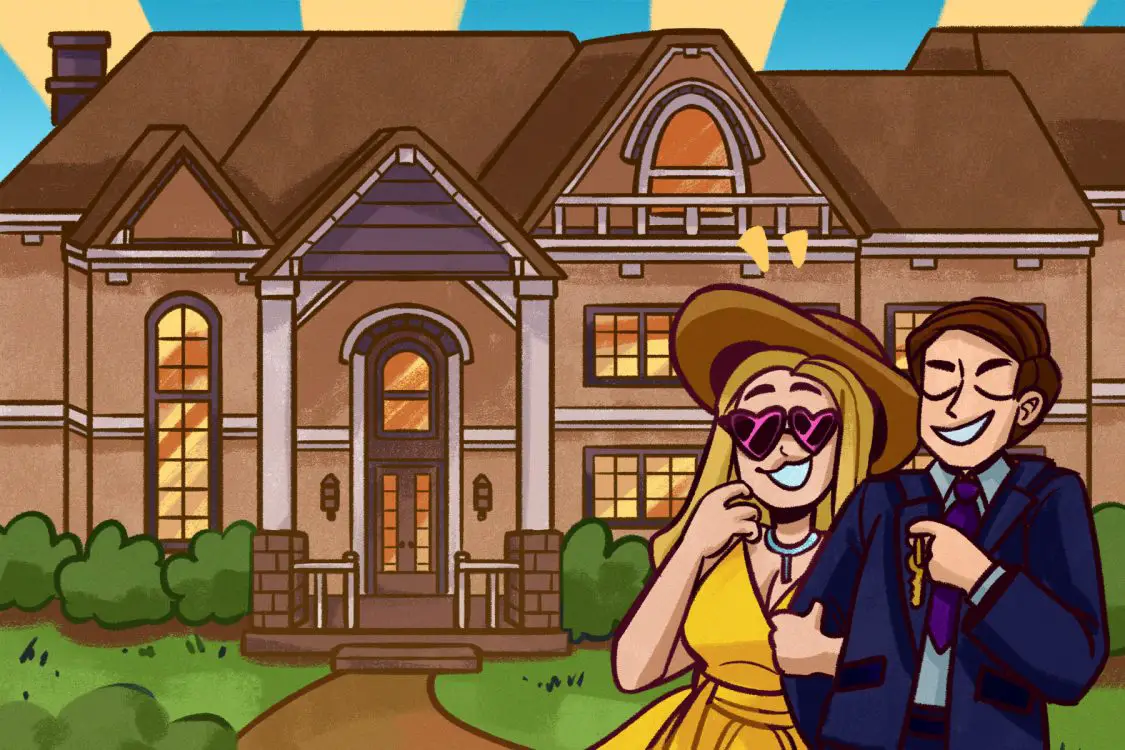Where can one see a castle turret, barn doors and Greek columns all in one structure? America, of course. Many suburban neighborhoods have them — gaudy mansions with an abundance of misplaced windows, bland color schemes and an incohesive mix of architectural styles. They seem to materialize out of nowhere and loom with superiority over the surrounding smaller, quaint homes. Besides the people who like these homes, many Americans can probably agree: McMansions are ugly.
Taking its name from the infamous fast-food chain McDonald’s, these homes are similarly mass-produced, unsustainable long-term yet quickly obtained, and unequivocally American. Like an indulgent Big Mac, McMansions are enormous. According to the U.S. Census Bureau, in 2020 the average size of homes in the U.S. was around 2,200 square feet. McMansions range from 3,000 to 5,000 square feet, if not larger.
These structures emerged in the 1980s, revamping the dated style born from suburban mass migration during the mid-1940s and 1950s. This trend carried into the 1990s and early 2000s, reflecting a culture that associates success with material worth. Before the dreaded 2008 recession, maximalism in architecture reigned. Whether grand rooms with high cathedral ceilings or a Versailles-style spiral staircase, going all out was in style. The once trendy modest cottages with “Home Sweet Home” needlepoints adorning the walls seemed lightyears away.
While these opulent abodes are large, McMansions are distinct from mansions. The main difference is that these structures pose as something they are not. Like a Quarter Pounder from McDonald’s, they may look decadent, but they really aren’t that great. The architecturally whimsical features of historic mansions like the Wilderstein Mansion in Upstate New York are not present in the gaudy new builds. Instead of intricate designs, these structures contain a mishmash of styles, lack visual cohesion and include poorly made materials.
As Jackie Craven stated, location indicates that these are trophy homes meant to be flaunted. McMansions are not stone castles tucked into rolling hills or craftsman getaways on a rocky, oceanside cliff. They exist in the same realm as Hobby Lobby, minivans and perfectly coiffed topiary. McMansions reside in pure suburbia — and the use of Tuscan-style eaves won’t fool anyone into thinking otherwise. They’re an indicator of status through high mortgages, reflecting wealth inequality. As a result, some pretend they’re American royalty while others struggle daily with food insecurity.
McMansions also disregard the need for environmental sustainability and require an excessive amount of energy and supplies. The Huffington Post even stated that the only way to make a McMansion more environmentally friendly is by demolishing it and building two standard homes in its place. Others, like writer Galina Tachieva, believe the answer is to repurpose these large structures into multi-unit apartments. This would help diversify once closed-off communities by integrating people that couldn’t previously afford to live in suburbia.
The normalization of exorbitant land consumption and overuse of resources is telling, as the wealthy to moderately wealthy are allowed to use and abuse without consequence. With the risk of climate change and affordable housing becoming increasingly scant, shouldn’t there be a limit on what one can build? In 2019, Seattle Councilmen Mike O’Brien proposed and successfully passed a bill that banned such maximalist abodes.
One begins to wonder how something so gaudy became so cookie cutter. To the untrained eye, most McMansions look very similar: faux stone, built-in garages and an abundance of massive, awkwardly placed windows. The blog McMansion Hell is famous for exposing the absurdities of these inelegant structures. Featuring the commentary of Kate Wagner, the posts are brilliant comical roasts of the garish houses from real estate listings.
The blog is wry and approachable, stating things like “ahoy mateys” in reference to a porthole-like window and “can we just, like, ctrl-x this part of the house” about a botched wall. Beyond its humorous format, Wagner’s work is powerful and critiques an American mentality that equates overconsumption with success. Her chosen homes are tacky because they try to look sophisticated and worldly.
The structures are often made with cheap materials, but still reflect a cultural love of wealth and status. Wagner stated in an interview with Ariana Rebolini that she loathes “the pretentiousness of [McMansions]. It’s appropriating architectural languages of the past, like certain types of columns, in order to denote an appeal to authority, architecturally. By putting columns on your front door, it’s saying you have the same amount of power as an institution like a bank or government office. We’ve codified certain symbols as symbols of wealth.”
The wealth-obsessed flamboyance of McMansions is why their roofs, for instance, are so odd. Wagner stated for Business Insider that McMansions are built inside-out, making the roofs a mishmash of nonsensical lines that try desperately to accommodate the showy interiors.
As Wagner often points out, McMansions make people feel small on purpose by towering over them. Through this, there is a strange clash of purpose in the McMansions. Homes, after all, are supposed to be intended for human habitation, yet when they’re so overbearingly large, the houses seem almost anti-human and belittling.
As the Washington Post suggests, perhaps we hate McMansions because they symbolize a late-stage capitalist American dream that can be monetarily transient, evidenced by the 2008 recession. According to Business Insider, McMansions are a dying breed, stating, “To cite one example, in Fort Lauderdale, Florida, the extra money that buyers were expected to be willing to pay to own a McMansion fell by 84% from 2012 to 2016.”
But, as a result, McMansions across the country sit foreclosed due to loss of wealth, leaving their grand halls spawning cobwebs and their topiaries overgrown. Wagner explains in another interview that McMansions are “too ostentatious to be considered folk architecture,” implying that they are devoid of a distinct artistic identity.
When millions of these structures exist, where does one categorize them within the sphere of American design? With their strange mix of inexpensive utilitarianism and garish unneeded embellishments, they’re both lacking and over abundant. As a result, the style of McMansions is an arguable reflection of American wealth at large, functioning on a system that is simultaneously on shaky foundation and indulged in opulence.

















